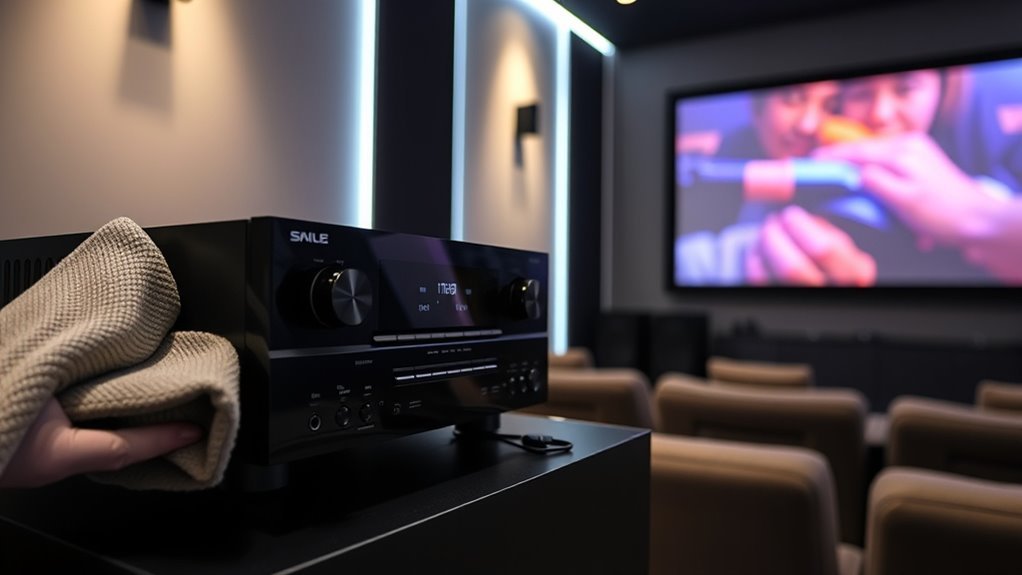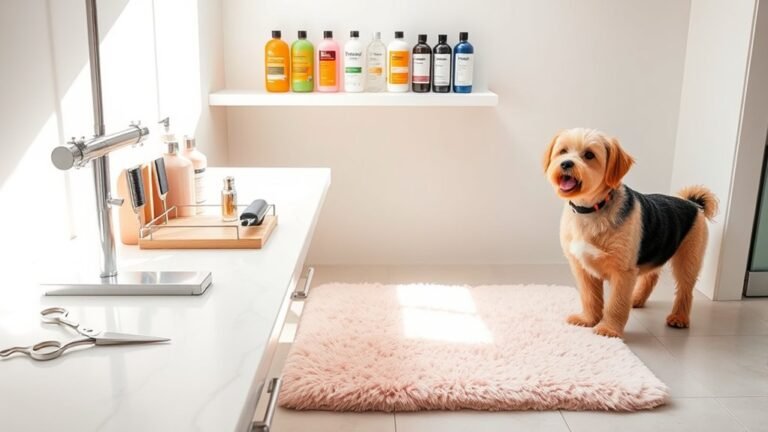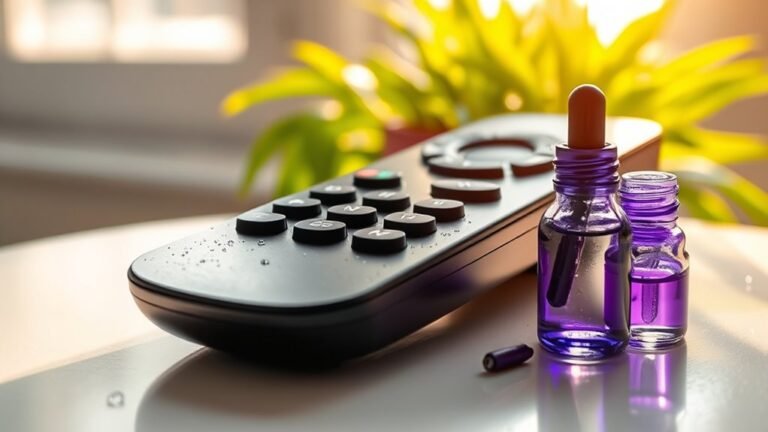How to Clean and Maintain a Home Theater System
To clean and maintain your home theater system, start by unplugging everything and gathering microfiber cloths, compressed air, and gentle brushes. Dust speakers and subwoofers carefully to avoid damage, and wipe screens with soft cloths using circular motions. Organize cables with ties and label them for easy ID, while regularly cleaning remotes and accessories. Keep vents clear and schedule routine checks to catch issues early. Stick around to discover tips that keep your system sounding and looking its best.
Preparing Your Home Theater System for Cleaning

Before you begin cleaning your home theater system, make sure to power it off and unplug all components. This essential step guarantees your safety and protects your equipment from damage. Next, create a pre cleaning checklist to organize the process efficiently. Include tasks like dusting surfaces, checking cables, and clearing clutter around the system. Gather the right cleaning supplies—microfiber cloths, compressed air, gentle cleaning solutions, and soft brushes are ideal. Avoid harsh chemicals that could harm delicate electronics. With your checklist and supplies ready, you’ll breeze through cleaning without missing any critical spots. Taking these preparatory steps gives you the freedom to maintain your system confidently, ensuring it stays in top shape without hassle or risk.
Cleaning the Speakers and Subwoofers
When cleaning your speakers and subwoofers, gently remove dust using a soft, dry cloth or a can of compressed air to avoid damaging delicate components. Be careful not to press too hard on speaker cones or grills, as they can be easily damaged. Protecting these parts guarantees your system sounds great and lasts longer.
Dust Removal Techniques
Keeping your speakers and subwoofers free of dust is essential for preserving sound quality and extending their lifespan. You want to adopt effective dusting techniques that won’t harm delicate components. Using the right cleaning tools makes the job easier and safer, so you stay in control of your system’s performance.
Here are some dust removal techniques to assess:
- Use a soft microfiber cloth to gently wipe down surfaces without scratching.
- Utilize a can of compressed air to blow dust out of speaker grills and hard-to-reach spots.
- Employ a small, soft-bristled brush to loosen stubborn dust from crevices without damaging cones or surrounds.
With these simple methods, you maintain freedom from interference and keep your home theater sounding crisp and clear.
Protecting Speaker Components
Three key steps can help you protect your speaker components while cleaning them effectively. First, always unplug your speakers and subwoofers to avoid damage or shocks. Next, use a soft, dry microfiber cloth to gently wipe down speaker enclosures, steering clear of harsh chemicals that can harm finishes or acoustic treatment materials. For stubborn dirt on speaker cones, lightly dampen the cloth with water—never spray directly. Finally, keep your acoustic treatment dust-free by vacuuming with a brush attachment or using compressed air carefully. By following these steps, you preserve your system’s performance and extend its lifespan, giving you the freedom to enjoy immersive sound without worry. Clean, protected speakers mean your home theater stays crisp and vibrant for every movie night.
Maintaining the Display Screen

Although the display screen is one of the most delicate components of your home theater system, you don’t have to worry about damaging it if you clean it properly. Keeping your screen in top shape not only preserves image quality but also helps maintain peak screen brightness and display calibration. Here’s how you can care for it without hassle:
- Use a microfiber cloth to gently wipe the screen in circular motions, avoiding harsh chemicals.
- Adjust screen brightness regularly to suit ambient lighting, preventing eye strain and extending screen life.
- Perform display calibration every few months to keep colors vivid and true, enhancing your viewing freedom.
Dusting and Cleaning the Remote Controls and Accessories
Since remote controls and accessories are handled frequently, they tend to collect dust, fingerprints, and grime quickly. For effective remote care, start by wiping the remote with a microfiber cloth slightly dampened with a mixture of water and isopropyl alcohol. Avoid soaking it to protect the internal electronics. Use cotton swabs dipped in the same solution to reach tight spots like buttons. For accessory upkeep, gently dust speakers, headphones, and other peripherals with a soft brush or cloth. Regular cleaning prevents buildup that can affect performance and your overall experience. Keeping your remotes and accessories clean not only extends their lifespan but also guarantees smooth operation, giving you the freedom to enjoy your home theater system without interruption or hassle.
Organizing and Protecting Cables and Connectors

When you set up your home theater system, keeping your cables and connectors organized is essential for both safety and performance. Good cable management not only prevents tripping hazards but also helps your system run smoothly without interference. To keep things free and clear, focus on these key steps:
- Use cable ties or Velcro straps to bundle cables neatly and avoid tangling.
- Label each cable near the connector to quickly identify connections without unplugging.
- Invest in protective covers or sleeves for connectors to prevent dust buildup and physical damage.
Checking and Replacing Filters and Vents
Keeping your cables organized helps maintain your home theater’s overall health, but it’s just as important to pay attention to filters and vents. Different filter types trap dust and allergens, ensuring your system runs smoothly without overheating. You should regularly check vent locations—like behind your receiver or near your projector—to prevent blockages. Replacing filters when clogged preserves airflow and extends your gear’s life. Here’s a simple guide to keep you on track:
| Component | Filter Type | Vent Location |
|---|---|---|
| AV Receiver | Foam or Mesh | Rear panel |
| Projector | Electrostatic | Side or bottom |
| Speaker Subwoofer | None or Paper | Base or back |
| Media Player | None | Rear vents |
| Amplifier | Fiberglass | Front or back panel |
Stay free from overheating hassles by keeping filters clean and vents unobstructed.
Scheduling Regular Maintenance and Performance Checks
Although routine cleaning is essential, scheduling regular maintenance and performance checks guarantees your home theater system stays in top condition. Setting up a performance schedule helps you avoid unexpected issues and keeps everything running smoothly. Use a maintenance checklist to track tasks like inspecting cables, checking speaker alignment, and updating firmware. This proactive approach frees you from last-minute troubles and lets you enjoy your system without interruptions. Here’s a simple routine to follow:
- Review your maintenance checklist monthly to catch small problems early.
- Schedule quarterly performance checks to test audio and video quality.
- Keep a log of any repairs or adjustments to monitor system health over time.
Frequently Asked Questions
Can I Use Household Cleaners on My Home Theater Components?
You shouldn’t use just any household cleaner options on your home theater components because they may damage delicate surfaces or electronics. Instead, stick to safe cleaning methods like using a microfiber cloth slightly dampened with water or a gentle, electronics-safe cleaner. This way, you maintain freedom to enjoy your system without risking harm. Avoid harsh chemicals, and always unplug devices before cleaning to keep everything safe and sound.
How Often Should I Upgrade My Home Theater System?
Oh sure, you should upgrade your home theater system every week—because who doesn’t want to bankrupt themselves chasing the latest gadget? In reality, your upgrade frequency depends on your system lifespan and how much freedom you want from constant spending. If your setup still delivers great sound and picture, hold tight. Only when tech leaps or your system struggles should you consider an upgrade. Enjoy your freedom—don’t be a slave to upgrades!
What Is the Best Way to Store Unused Speakers?
When it comes to speaker storage, you’ll want to prioritize speaker protection to keep them in top shape. Wrap each speaker in a soft cloth or bubble wrap to shield it from dust and scratches. Store them in a cool, dry place away from direct sunlight and moisture. Avoid stacking heavy items on top, so your speakers stay safe and ready for when you want to enjoy your freedom with great sound again.
Can Pets Damage My Home Theater Equipment?
Did you know over 60% of pet owners report accidental damage to their electronics? When it comes to pet safety and equipment protection, you’ll want to keep your home theater gear out of reach. Curious cats might claw speaker covers, and dogs could chew cables, risking both your gear and their safety. By setting boundaries, you enjoy your system freely while keeping your furry friends and valuable equipment safe and sound.
Is Professional Calibration Necessary for Optimal Sound Quality?
You don’t have to get professional calibration to enjoy great sound quality, but it can make a big difference if you want your system to perform at its best. Professionals use specialized tools to fine-tune your speakers, ensuring balanced audio tailored to your room’s acoustics. If you’re all about freedom and tweaking things yourself, that’s cool too—but professional calibration can save you time and release your system’s full potential.






